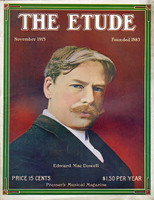By E. W. Morphy
Every violin student who has once heard the broad, soulful tone of a truly great artist is to a more or less degree fired with a desire to acquire the same valuable asset. If he is endowed with a high-strung musical temperament he may not need suggestions as to how to produce tone, for there are some who have such a desire for a noble tone that they hold the ideal before themselves so tenaciously that in time they catch the trick of how to produce it. However, there are others who long for the skill to make tone that will attract and hold the attention of critical listeners, but have difficulty in making the physical obey the dictates of the soul. It is a case of where "the spirit is willing, but the flesh is weak." In fact, it is not unusual to meet people who have all the warmth of soul, the mental acuteness, and the deep appreciation to become great musicians, but lack the power to overcome the physical conditions necessary to develop technic. In other words, they seem unable to "connect up" with their instruments; there is no co-ordination of their souls and the tone-producing medium.
Developing a Big Tone
In the first place, any student who hopes to produce even a fairly satisfactory tone must see that his violin and bow are in fine playing condition. I have had students come for assistance whose violins were open in many places; fingerboards warped; false strings which never agreed with the instrument, or with each other; bridges badly fitted, being too thick or too thin, too high or oftentimes too low. Once a student arranged for lessons whose violin was minus a sound- post, and when questioned as to what became of it he said: "I thought some of my friends put that little stick inside for a joke, so I fished it out and threw it away." Not so strange, however, as one who came with two sound-posts in his violin, one standing in its proper place, and another rolling around ad libitum.
Besides seeing that the violin is in its best health, it is also necessary that the bow be a good one and properly filled with hair. After using a bow for some time the hair becomes smooth and will not bite the string satisfactorily. Even with good hair, the question of the right kind and the right amount of rosin needs consideration. Big tone of the correct kind is impossible without a good violin and bow; both in the best possible condition.
With the equipment in good form, the student is recommended to try the following exercise and observe the result in the growth of his tone. Try a slow scale in the third position, with the head of the violin well elevated. The elevation will cause the bow to stay near the bridge rather than near the end of the fingerboard. Big tone cannot be made by bowing where the string does not offer resistance. The third position is chosen, to begin with, in order that there need be no clutching of the instrument with the left hand, the neck, or the jaw, since absolute relaxation is highly desirable. Be sure to see that each finger is set with its tip upon the string, and that the string is pressed firmly on the finger-board. It is also imperative that the finger is so placed that the tone produced causes sympathetic vibrations to start on other strings. In other words, when the second finger playing D on the G string is correctly placed it causes the open D string to vibrate. This is true of many other tones, as the student will find out for himself if he will play slowly and listen.
With the fingers in the right places the bow processes must next have some attention. Begin by playing many strokes at the frog on each note of the scale. Keep the wrist perfectly flexible. I say, flexible; not loose. There is a great difference between controlled flexibility and loose flabbiness. When the wrist is flexible let the weight of the arm rest down on the bow; at least as much weight as is possible without causing a scratchy tone, and it will be seen that the weight of the arm is a powerful factor in tone production. It will also be noticed that the wrist has a slight tendency to drop below the level of the hand, and the bow seems to "cling" to the string. Follow this by drawing the bow very slowly throughout its entire length ; keeping the forefinger pressed firmly on the stick, increasing the leverage as the tip is approached. The sensation is not unlike "pulling" taffy candy. The depression of the wrist will be quite noticeable on the down stroke, and less so on the up stroke. The latter is made powerful by a good strong roll of the forearm and wrist onto the first finger, the same as the motion which causes the firm staccato to be crisp. Add now a good free vibrato of the left hand and you will be so pleased with the effect that you will want to use it on an inspired melody,— do so, since that is the very best use you can make of a delightful, sonorous tone.



